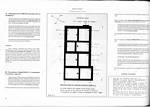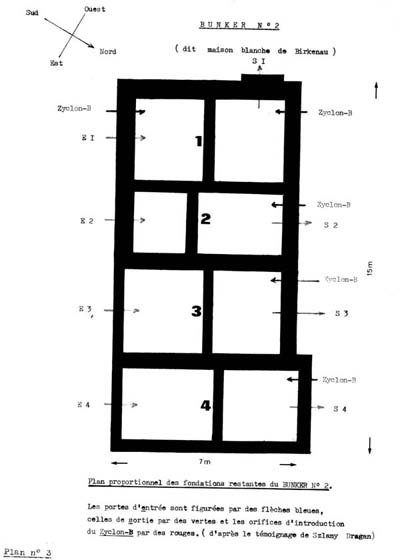|
|
 |
 |
AUSCHWITZ:
Technique
and Operation
of
the Gas Chambers © |
|
|
| |
 |
Back |
 |
Contents |
Page 174 |
 |
Home
Page |
Forward |
 |
| |
| II/ Declaration by Pery BROAD concerning “the two
farmhouses”: |
| |
“Not far from Birkenau, which was rapidly
expanding, there were two pretty and neat peasant cottages in a pleasant site.
Separated by a copse, they were whitewashed and covered with nice thatched
roofs. All around were fruit trees. This was one's impression at first sight.
Nobody would have believed that the number of people assassinated in
these two inoffensive looking houses corresponded to the population of a big
town. However, a careful observer would have noticed first of all on the walls
of these houses signs with an inscription in several languages: “to
disinfection”. He would then have discovered that the houses had no
windows, but on the other hand had an astonishing number of doors of an
extraordinary thickness, sealed with rubber and fitted with latches that could
be screwed tight. Near to these doors there were small wooden shutters.
He would also have noticed, beside these houses, several big stable
type huts, similar to those prisoners lived in at Birkenau”
|
| Comments: |
| |
| There is perhaps a translation error with word
“copse”. Replacing this by “small wood”, the declaration
validates itself . In this case Pery Broad can be speaking only of Bunker 2
(white cottage with an astonishing number of doors see Document 5),
though also he mentions the existence of Bunker 1 that he never seems to have
seen. The doors sealed with rubber are entirely imaginary. They were sealed
with felt. The inscription “to disinfection” in several
languages would appear to show that Broad was in fact talking of the
installation known as Bunker V in summer 1944. His declaration therefore
concerns Bunker 2/V only |
| |
| III/ The testimony of Rudolf HOESS
["Commandant of Auschwitz", page 211] |
| |
"During the spring of 1942 the actions were
comparatively small, but the transports increased in the summer, and we were
compelled to construct a further extermination building. The peasant farmstead
west of the future site of crematoria III and IV [IV and V] was selected and
made ready. Two huts near Bunker 1 and three near Bunker 2 were erected, in
which the victims undressed. Bunker 2 was the larger and could hold about
1200 people. |
| [or about 13 people per square meter, a physically
impossible density]. |
| |
 |
Document 4, Drawing 3
Foundation plan [Drawing by the author] |
|
| |
Translation of
inscriptions: |
|
| |
|
|
| · |
Nord, Sud, Est, Ouest
/ North, South, East, West |
|
| · |
BUNKER 2 (dit maison
blanche de Birkenau /
BUNKER 2 (known us the Birkenau “white
house”) |
|
| · |
Plan proportionnel
des fondations restantes du Bunker No 2 / Scale plan of the remaining
foundations of Bunker 2 |
|
| · |
Les portes d'entrees
sont figurées par des flèches bleues, celles de sortie par des
vertes et les orifices d'introduction du Zyklon-B par des rouges
(d'aprés le témoignage de Szlam[y] Dragon /
The entrance
doors (E) are shown by blue arrows, the exit doors (S) by green and the Zyklon
B introduction orifices by red (based on the testimony of Szlam[y] Dragon).
|
|
| |
|
|
Extracts from "Der Auschwitz
Prozess" by Hermann Langbein, Volume 1
Page 72: Testimony of
Dr. Johann Paul KREMER , reserve Second Lieutenant, who was at Auschwitz
from 30/8/42 to 18/11/42. |
| |
“Old farmhouses had been converted into
bunkers and fitted with a sliding door that closed perfectly. Above there was
an opening. Naked men were sent in there. They entered without suspecting
anything, very few resisted and these were taken aside and shot. The gas was
introduced by a member of the SS. To do this, he had to climb a
ladder” ... |
[It is impossible to say whether Dr. Kremer is
speaking of Bunker 1 or 2].
Page 73: Testimony of SS private
HÖBLINGER, replying questions: |
| |
“ I was detailed to the transport service
and I drove the Sanka (abbreviation for Sanitätskraftwagen / medical
truck) which was to carry the prisoners…
Then we drove to the gas
chambers. The medical orderlies climbed a ladder, they had gas masks up there,
and emptied the cans. I was able to observe the prisoners while they were
undressing. It always proceeded quietly and without them suspecting anything.
It happened very quickly."
Presiding Judge: "How long did the gassing
take?"
Höblinger: "About one minute. When the gas penetrated, we
could hear cries of horror. One minute afterwards, everything was silent. The
gas was brought in cans by the SDG (Sanitätsdienstgrade/SS NCO medical
orderlies)…” |
| |
| [It is again impossible to situate this scene
specifically at Bunker 1 or 2] |
|
| |
AUSCHWITZ:
Technique and operation
of the gas
chambers
Jean-Claude Pressac
© 1989, The Beate Klarsfeld Foundation |
 |
Back |
Page 174 |
Forward |
 |
|

